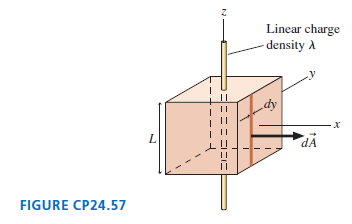All examples of Gausss law have used highly symmetric surfaces where the flux integral is either zero
Question:
This is worth checking. FIGURE CP24.57 shows a cube of edge length L centered on a long thin wire with linear charge density λ.
The flux through one face of the cube is not simply EA because, in this case, the electric field varies in both strength and direction. But you can calculate the flux by actually doing the flux integral.

a. Consider the face parallel to the yz-plane. Define area dA as a strip of width dy and height L with the vector pointing in the x-direction. One such strip is located at position y. Use the known electric field of a wire to calculate the electric flux dΦ through this little area. Your expression should be written in terms of y, which is a variable, and various constants. It should not explicitly contain any angles.
b. Now integrate dΦ to find the total flux through this face.
c. Finally, show that the net flux through the cube is Φe = Qin/є0.
Fantastic news! We've Found the answer you've been seeking!
Step by Step Answer:
Related Book For 

Physics for Scientists and Engineers A Strategic Approach with Modern Physics
ISBN: 978-0133942651
4th edition
Authors: Randall D. Knight
Question Posted:





